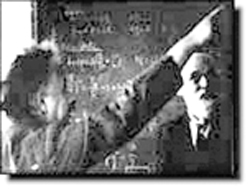Einstein's Biggest Blunder
 Einstein and de Sitter |
Shortly after formulating his theory of general relativity, Einstein collaborated in 1917 with the Dutch astronomer Willem de Sitter to demonstrate that his equations could be used to describe a highly simplified universe. This model was adapted by other scientists to describe the actual universe, but they quickly ran headlong into a version of Bentley’s paradox. The calculations indicated that the universe was changing with time.
Prevailing scientific opinion held that the universe was static, so Einstein introduced a mathematical "fudge factor" into his equations, known as the cosmological constant, or lambda. It implied the existence of a repulsive force pervading space that counteracts the gravitational attraction holding matter together. This balanced out the "push" and "pull" so that the universe would indeed be static.
Perhaps Einstein should have trusted his instincts. Twelve years later, Edwin Hubble was studying distant galaxies and noticed an intriguing effect in the light they emitted: it had a pronounced "shift" toward the red end of the electromagnetic spectrum. Hubble reasoned that this could only be happening if the light were traveling across space that is expanding. Einstein’s original equations had been correct, and there was no need for a cosmological constant. The cosmos was indeed still expanding. Einstein denounced lambda as his "greatest blunder."
Hubble’s discovery changed the Big Picture of how the universe will end. The attractive force of gravity would slow down the rate of expansion. Scientists spent the next 70 years trying to measure that rate. If they knew how the rate of expansion was changing over time, they could deduce the shape of the universe. And its shape was believed to determine its fate.
The more matter there is, the stronger the pull of gravity, and the more space will curve – making it more likely that the current expansion will halt and the universe will be "closed," i.e. will collapse back in on itself in a "Big Crunch." If there’s not enough matter, the pull of gravity will gradually weaken as galaxies move farther apart, and the universe will be "open," i.e. will expand forever with essentially no end. Scientists believed the universe was flat, i.e. on the border between open and closed, so the expansion would slow down indefinitely, but without recollapsing.
Just as physicists were getting comfortable with this idea, the story took an unexpected turn. In 1998, two separate teams of physicists measured the change in the universe’s expansion rate, using distant supernovae as mileposts. When Hubble made his 1929 measurements, the farthest red-shifted galaxies were roughly 6 million light years away. If expansion was now slowing under the influence of gravity, supernovae in the most distant galaxies should appear brighter and closer than their red shifts would suggest. Instead, at high red shifts, the most distant supernovae are dimmer. The expansion of the universe is speeding up.
It’s a testament to Einstein’s genius that even his blunders prove to be significant. Lambda implied the existence of a repulsive form of gravity, and such a thing appears to be the driving force behind cosmic acceleration: it’s called dark energy. If dark matter gives rise to the gravity that holds the universe together, then dark energy is the counter-force pushing the universe apart. As the universe continued to expand, the dark matter density, and hence the gravitational pull, decreased until it was less than that of the dark energy. So instead of the expected slow-down in the expansion rate, the now-dominant dark energy began pushing the universe apart at ever-faster rates.
The simplest example of repulsive gravity can be found in the quantum vacuum, which is teeming with virtual particles that wink in and out of existence. But the numbers don’t add up. The quantum vacuum contains far too much energy density: roughly 10120 times too much. So the universe should be accelerating much faster than it is. An alternative theory proposes that the universe may be filled with an even more exotic, evolving form of dark energy dubbed "quintessence."
The dark energy could be the result of the influence of unseen extra dimensions predicted by string theory. Alternatively, in 2004, scientists at the University of Washington proposed that the dark energy could be due to neutrinos interacting with hypothetical particles called "accelerons." Or perhaps there is no such thing as dark energy, and general relativity is not an accurate description of gravity after all.
Thanks to cosmic acceleration, the shape of the universe will no longer determine its ultimate fate. Instead, its fate rests on whether the dark energy is constant or changing. All the observations to date indicate that the dark energy is constant. If so, the acceleration will continue indefinitely, and matter will grow farther and farther apart. Within a hundred billion years, we will only be able to see a few hundred galaxies, compared to the hundreds of billions we can see today.
©1995 - 2024, AMERICAN PHYSICAL SOCIETY
APS encourages the redistribution of the materials included in this newspaper provided that attribution to the source is noted and the materials are not truncated or changed.
Associate Editor: Jennifer Ouellette
Staff Writer: Ernie Tretkoff
July 2005 (Volume 14, Number 7)
Articles in this Issue

